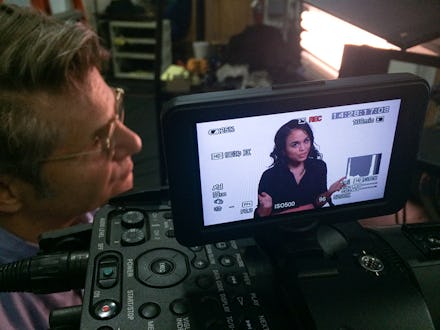How "The Whiteness Project: Intersection of I" Makes White People Grapple With Privilege

A young, tan white girl with long, flowing brown hair fidgets uncomfortably, laughing awkwardly at her own exasperation. "Everything is made into a racist something now," she tells the camera, and she doesn't like it. A lot of problems are made into race problems, she tells us — "We're all different. Get over it."
She's both glib and earnest. She seems to truly believe she sees no color, as she notes, and that she's never benefited from her whiteness.
Read more: The 'Whiteness Project' Is Back, and It's Whiter and More Revealing Than Ever
Makenna, 21, was one of 23 white Millennials (ages 15-27) interviewed in Dallas in July 2015 that make up part of Whitney Dow's second installment of his Whiteness Project, "Intersection of I," which was turned into an installation at this year's Tribeca Film Festival for its "Storyscapes" program. Every filmed interview ends with a statistic that informs, reframes or further contextualizes these short personal testimonies. In Makenna's case: "84% of millennials say their family taught them that everyone should be treated the same no matter their race."
Does this bolster the young woman's pleas that we should all get along and stop turning everything "into a racist thing?" Or does it suggest a vision of colorblindness that is at odds with how non-white people experience their own lives?
Just as he did with "Inside the White Caucasian Box" — a collection of 21 interviews with white Buffalo residents that kicked off what he describes as an "interactive investigation into how Americans who identify as white, or partially white, understand and experience their race" — Dow is not aiming for low-hanging fruit. Makenna's words ("Duh, everyone hates racism") are put side by side with Wade's views on our inability to examine "systemic racism." This variety within a small if representative sample is what makes the Whiteness Project such a fascinating endeavor.
Just as one is ready to dismiss someone's claims that "if you want to stop racism, you have to stop talking about it" — courtesy of Leilani, 17 — there are thrilling moments of self-examination. Connor, 24, for example, finds himself checking his own privilege as he talks.
"I always knew that if I got in trouble I could just get a lawyer, suit up, show up and, you know, get a slap on the wrist," he says. He never thought about it before, he admits. At the end, Dow helpfully glosses the issue: "White men are six times less likely to be incarcerated than black men."
The project, which lives online at whitenessproject.org, encourages those browsing and watching to engage in conversation. Dow's ongoing project is to get America to examine whiteness (as bias, as race, as culture, as privilege), but his "Intersection of I" installation asks us to go further.
First of all, it required all visitors to have their skin tone photographed before being allowed in to see Dow's installation.
The picture then gets added to a projection up on one wall under the title "What is white?" It's an immediately alienating experience: You're quite literally reduced to your skin tone.
That small gesture is but one of the ways in which Dow's installation encouraged its visitors to write themselves into the conversation he's staging. To get one of the taped interviews to play on the other wall, visitors needed to speak the name of the person they wanted to hear from into a microphone.
While the interviews are the same as the ones hosted on Dow's website, there is something to be said about their impact when blown up and projected for a rapt audience. With a blank white background, it's easier to notice Mexican-American's Nick's "Bronxville, USA" T-shirt (complete with an American flag) and really get a chance to examine Wade's many piercings. More importantly, the videos projected differ in one crucial way from their online versions: They caption the testimonials.
It's one thing to hear Chaney, 18, talk about how she doesn't support the notion of reparations, but it's quite another to see her words ("Like, I didn't do anything to you guys, so step off?") juxtaposed with her nervous laughter. It creates a jarring disconnect, and one wonders what Dow's interviewees would make of their own words being put in this new context.
As infuriating as it is enlightening, "Intersection of I" is timely — necessary, even. In Dow's own words: "I believe that the country is not only ready for a discussion on whiteness, but is hungry for it." Consider this your first taste.